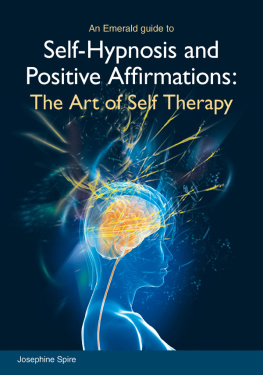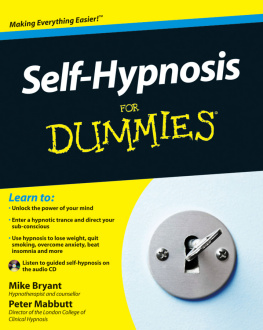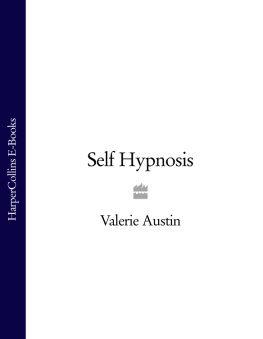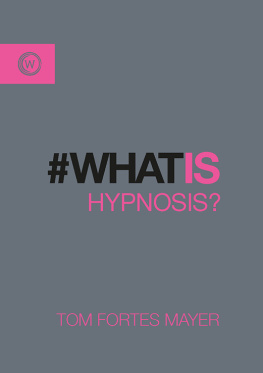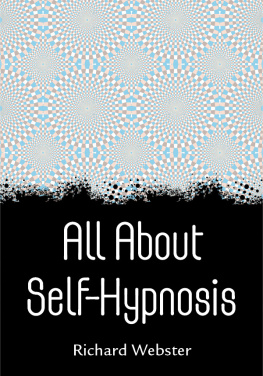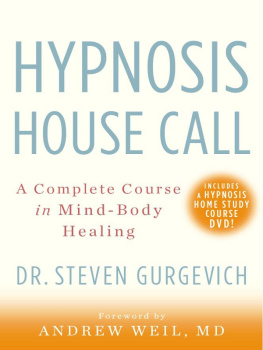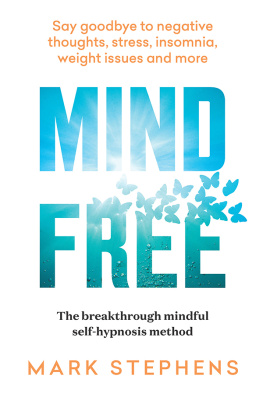Self-Hypnosis and Positive
Affirmations:
The Art of Self Therapy
Josephine Spire
www.emeraldpublishing.co.uk
Emerald Publishing
Josephine Spire 2015
All rights reserved. No part of this publication may be reproduced in a retrieval system or transmitted by any means, electronic or mechanical, photocopying or other wise, without the prior permission of the copyright holder.
British Cataloguing in Publication data. A catalogue record is available for this book from the British Library.
ISBN
978-1-84716-499-5
eISBN: 978-1-84716-554-1
Printed in the United Kingdom by 4edge Ltd www.4edge.co.uk
Cover Design by Straightforward Graphics
Whilst every effort has been made to ensure that the information in this book is accurate at the time of going to print, the book is sold on the understanding that no responsibility for errors and omissions is assumed and no responsibility is held for the information held within.
ACKNOWLEDGEMENTS
This book is dedicated to my beloved parents Joseph and Elizabeth who are my inspiration, a big thank you to them for all the sacrifices they made to provide me with a great education, I love you tremendously and miss you everyday, thank you for watching over me and guiding me from up above, this book wouldnt be here without you.
I also express my gratitude to my amazing family for their endless love, support, patience, for holding my hand and standing beside me through thick and thin. I adore you all.
I thank all my friends I wont be able to name you all here but you know who you are, thank you for being there for me, supporting me and most of all loving me. I hope you know how much I love and appreciate your friendship.
A big thank you to Roger Sproston and your team at Emerald Publishers, it has been a privilege to work with you.
And last but not least I thank my children Alex and Ariana for loving me unconditionally, making me smile everyday and for enriching my life. I love you with all my heart.
***************
C ONTENTS
***************
INTRODUCTION
There are so many things said about hypnosis but the most important of all is the fact that hypnosis heals! Hypnosis can be amazingly effective and is often directly responsible for major changes in peoples lives. Research, studies and statistics indicate that hypnosis has gained popularity and acceptance as a part of evolution of our health care system and that a vast number of people are using hypnosis as a treatment or for relief of symptoms for both physical and psychological illnesses. Hypnotic techniques are safe and effective for quitting smoking, weight control, pain management, childbirth, anxiety, stress management, depression, insomnia, panic attacks, addictions, lack of confidence, nail biting, anger management, motivation, sports performance, treating and relieving phobias and also help with self-empowerment.
This book is designed for self-therapy which can be practiced safely with self-hypnosis, positive affirmations, relaxation and breathing techniques which all have a hypnotic component. These techniques should provide a basis for learning self-hypnosis for self-therapy. However you should always discuss your symptoms with your doctor first especially in cases of on going undiagnosed illness.
Positive affirming on the other hand is another technique for mind power, positive affirmations are very powerful that they give you the power to radically transform your life starting with positive thinking and eliminating negative thought patterns that stop you from achieving your desired goals. Its well known that what the mind focuses on it will manifest and that success or failure starts in the mind!
In my experience and thinking the combination of self-hypnosis and positive affirmations will yield tremendous benefit to your self-therapy process.
Why this book and how can it help you?
There are so many brilliant books out there about self-hypnosis and positive affirmations but there isnt a book that combines the two techniques. This book not only combines self-hypnosis and positive affirmations, it also provides you with information, advice and further resources so that you can be fully informed about your condition and managing it. I hope that you find this book informative and helpful and that it will inspire you to make those positive changes that you need to make in your life by using the power of your mind and positive thinking.
Josephine Spire
***************
C hapter One
A History of Hypnosis
Franz Anton Mesmer (1734-1815) is widely known as the modern father of hypnosis and the story of hypnosis follows on with one of Mesmers disciples, who had originally been persuaded by his two brothers to join a new society called The Society of the Harmony. This was run by Mesmer himself with a little time on his hands on leave from the army. His first subject was deeply hypnotisable, falling asleep with his subconscious, however, staying awake, he could talk to the patient asking him questions and getting replies. He went on with others to find that his first patient was not unique after all. Mesmer discovered that the cures involved were not due to animal magnetism but suggestion. He went on to develop the eye fixation technique, the state that resulted from this was what he originally called hypnosis.
Dr John Elliotson was the first to demonstrate the use of hypnosis in British medicine. Before an audience of 200 medics he cured a dumb epileptic using Mesmerism and also used hypnosis in operations.
In France, Auguste Ambroise Leibeault and Hippolyte Bernheim (1837-1919) were the first to regard hypnosis as a normal phenomenon. They emphasized that expectation was the most important factor in the induction of hypnosis and that hypnosis works by mental influence. It is at this time when hypnosis was gaining acceptance and recognition that Sigmund Freud (1856-1939) an Austrian neurologist became interested in hypnosis and decided to visit Leibeault and Bernheim at their hypnosis clinic to learn their induction techniques, as he observed people enter hypnotic trances, he began to recognize the existence of the subconscious. The trance state is now widely recognized as a highly effective tool in behavioural change and healing.
Later on Milton Erikson (1901-1980) developed many ideas and techniques in hypnosis that were very different from what was commonly practiced. He believed that the unconscious or subconscious mind was always listening, he also maintained that going into a trance is an everyday occurrence, something that human beings do everyday for example when driving, listening to the radio, reading, walking, and other forms of activities that get the mind to concentrate and stay still. It is common and normal to go into a trance while you are immersed in an activity.
WHAT IS HYPNOSIS?
Hypnosis is a state of mind brought about by the use of a set of techniques. The word hypnosis comes from the Greek word for sleep. Hypnosis is a deeply relaxed state where your mind can help you to focus extremely well on any task that either you with self-hypnosis or your hypnotherapist suggest to help you.
Hypnosis enhances an individuals concentration and increases their responsiveness to suggestion in order to make the beneficial changes that an individual may wish to make in their thought patterns, their behaviours or their physiological state. Hypnosis used for therapeutic purposes becomes hypnotherapy.
THE MIND
The mind is an element of an individual that enables them to be aware of their surroundings and experience feelings, thoughts, actions and emotion. The mind can be broken down into two parts;

